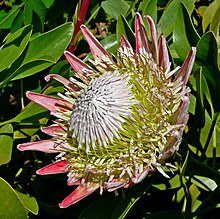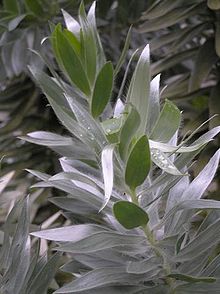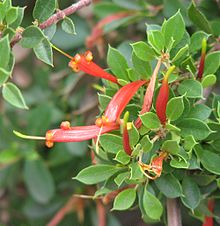Proteaceae
| Proteaceae Temporal range: [1]
| |
|---|---|

| |
| Inflorescence of Protea cynaroides | |
| Scientific classification | |
| Kingdom: | Plantae |
| Clade: | Tracheophytes |
| Clade: | Angiosperms |
| Clade: | Eudicots |
| Order: | Proteales |
| Family: | Proteaceae Juss.[2] |
| Genera | |
|
About 80, see text | |
The Proteaceae
Etymology
The name Proteaceae was adapted by Robert Brown from the name Proteae coined in 1789 for the family by Antoine Laurent de Jussieu, based on the genus Protea, which in 1767, Carl Linnaeus derived from the name of the Greek god Proteus, a deity who was able to change between many forms.[4][5] This is an appropriate image, seeing as the family is known for its astonishing variety and diversity of flowers and leaves.[citation needed]
Description

The genera of Proteaceae are highly varied, with Banksia in particular providing a striking example of adaptive radiation in plants.[6] This variability makes it impossible to provide a simple, diagnostic identification key for the family, although individual genera may be easily identified.
- Proteaceae range from prostrate shrubs to tall forest trees, of 40 m in height, and are usually of medium height or low or perennial shrubs, except for some Stirlingia species that are herbs. Some species are facultatively deciduous (Embothrium coccineum), rarely acaulescent, the cauline portion of the collar is often thickened (lignotuber). Indumentum of three-celled hairs, sometimes glandular, rarely absent, the apical cell is usually elongated, acute, sometimes equally or unequally bifid.
- mesophyll tissue usually with sclerenchymatous idioblasts, rare secretory cavities. Brachy-paracytic stomata (laterocytic in Bellendena).
Plant stems with two types of radii, wide and multi-serrated or narrow and uni-serrated, phloem stratified or not, trilacunar nodes with three leaf traces (rarely unilacunar with one trace), sclereids frequent; bark with lenticels frequently horizontally enlarged, cork cambium present, usually superficial. Roots lateral and short, often grouped in bundles (proteoid roots) with very dense root hairs, rarely with mycorrhiza.
- Plants usually hermaphroditic, more rarely monoecious, dioecious or andromonoecious.
- Inflorescences very variable, simple or compound, axillary or terminal, lateral flowers solitary or in pairs, rarely with a terminal flower, racemiform, paniculate or condensed, usually with bracts, sometimes converted into leaves or squamiform, forming a type of cone, or with bright colours, forming an involucre or pseudanthium, the peduncles and pedicels sometimes contracted, compacted with the rachis, in some cases the congested inflorescences form super inflorescences (some Alloxylon); very rarely the flowers are solitary and axillary near the end of branches; in species with lignotubers the flowers sometimes grow from these and pass through the soil (geophytes).
- style usually developed, stigma small or in the shape of a terminal or sub terminal disk or even lateral and oblique, often indented, papilous, moist or dry, ovules 1–100 or more per carpel, anatropous, hemianatropous, amphitropous or orthotropous, mostly hemitropous, bitegmic, crassinucellate, chalaza with a ring of vascular bundles, the funiculus is occasionally absent and the ovule is fused to the placenta, marginal placentationwith various dispositions or apical.
- Fruit dehiscent or indehiscent, in achene or nucule, follicle, drupe (with lignified endocarp) or falsely drupal (with lignified internal mesocarp), sometimes similar to a caryopsis as it is fused to the wall of the ovary and the testa, often lignified and serotinous; the fruit from the same inflorescence are sometimes fused forming a syncarp.
- Seeds 1-many, sometimes winged, flat to rounded, with endosperm absent, present in Bellendina, endotesta with an unusual layer containing crystals of calcium oxalate that is rarely absent, well differentiated embryo, straight, dicotyledonous, but often with 3 or more (up to 9) large cotyledons, often auriculate.
- Pollen in monads, triangular in polar view, (2-)3(−8)-aperturate, usually isopolar and triporate, biporate in Embothrium and the tribe Banksieae, colpoidate in Beauprea, spherical in Aulax and Franklandia or strongly anisopolar in some species of Persoonia; the openings of the former's tetrads follow Garside's Law.[clarification needed]
- Chromosomal number: n=5, 7, 10–14, 26, 28; sizes range from very small (average of 1,0 μm) to very big (average of 14,4 μm) according to species; x=7, 12.
Flowers
Generally speaking, the diagnostic feature of Proteaceae is the compound
Proteaceae flower parts occur in fours, but the four
Ecology

Many of the Proteaceae have specialised
There are four dioecious genera (
Distribution
Proteaceae are mainly a Southern Hemisphere family, with its main centres of diversity in Australia and South Africa. It also occurs in Central Africa, South and Central America, India, eastern and south eastern Asia, and Oceania.[8] Only two species are known from New Zealand, although fossil pollen evidence suggests there were more previously.[9]
It is a good example of a Gondwanan family, with taxa occurring on virtually every land mass considered a remnant of the ancient supercontinent Gondwana, except Antarctica. The family and subfamilies are thought to have diversified well before the fragmentation of Gondwana, implying all of them are well over 90 million years old. Evidence for this includes an abundance of proteaceous pollen found in the Cretaceous coal deposits of the South Island of New Zealand. It is thought to have achieved its present distribution largely by continental drift rather than dispersal across ocean gaps.[10]
Phytochemistry

No conclusive studies have been carried out on the chemical substances present in this broad family. The genera

Uses and cultivation

Many traditional cultures have used Proteaceae as sustenance, medicine, for curing animal hides, as a source of dyes, firewood and as wood for construction. Aboriginal Australians eat the fruit of
Two species of Macadamia are cultivated commercially for their edible nuts.
Many Proteaceae species are cultivated by the
Sugarbushes (
The species most valued as ornamentals are the trees that grow in southern latitudes as they give landscapes in
Among the banksias, many of which grow in temperate and Mediterranean climates, the vast majority are shrubs; only a few are trees that are valued for their height. Among the tallest species are: B. integrifolia with its subspecies B. integrifolia subsp. monticola, which is noteworthy as the plants that form the subspecies are the tallest trees of the banksias and they are the more frost-resistant than other banksias, B. seminuda, B. littoralis, B. serrata; among those that can be considered small trees or large shrubs: B. grandis, B. prionotes, B. marginata, B. coccinea and B. speciosa; all of these are planted in parks and gardens and even along roadsides because of their size. The rest of the species of this genus, around 170 species, are shrubs, although some of them are valued for their flowers.
Another species that is cultivated in some parts of the world, although it is smaller, is Telopea speciosissima (Waratah), from the mountains of New South Wales, Australia.
Some temperate climate species are cultivated more locally in Australia for their attractive appearance: Persoonia pinifolia (pine-leaved geebung) is valued for its vivid yellow flowers and grape-like fruit. Adenanthos sericeus (woolly bush) is planted for its attractive soft leaves and its small red or orange flowers. Hicksbeachia pinnatifolia (beef nut, red bauple nut) is commonly planted for its foliage and edible nuts.
Parasites

The Proteaceae are particularly susceptible to certain parasites, in particular the oomycete Phytophthora cinnamomi, which causes severe root rot in the plants that grow in Mediterranean climates. Fusarium oxysporum causes a disease called fusariosis in roots that causes a yellowing and wilting, with serious ecological damages to woodland plants and economic losses in plants of commercial interest. Other common infections are caused by species of Botryosphaeria, Rhizoctonia, Armillaria, Botrytis, Calonectria and other fungi.
Conservation status
The
Fossils

The Proteaceae have a rich fossil record, despite the inherent difficulties in identifying remains that do not show diagnostic characteristics. Identification usually comes from using a combination of brachy-paracytic stomata and the unusual
Taxonomy

First described by French botanist Antoine Laurent de Jussieu, the family Proteaceae is a fairly large one, with around 80 genera, but less than 2,000 species. It is recognised by virtually all taxonomists. Firmly established under classical Linnaean taxonomy, it is also recognised by the cladistics-based APG and APG II systems. It is placed in the order Proteales, whose placement has itself varied.
A classification of the genera within Proteaceae was made by

- Family Proteaceae
- Subfamily Bellendenoideae
- Subfamily Persoonioideae
- Tribe Placospermeae
- Tribe Persoonieae
- Tribe
- Subfamily Symphionematoideae
- Subfamily Proteoideae
- incertae sedis
- Eidothea — Beauprea — Beaupreopsis — Dilobeia — Cenarrhenes — Franklandia
- Tribe Conospermeae
- Subtribe Stirlingiinae
- Subtribe Conosperminae
- Subtribe
- Tribe Petrophileae
- Tribe Proteeae
- Tribe Leucadendreae
- Subtribe Isopogoninae
- Subtribe Adenanthinae
- Subtribe Leucadendrinae
- Leucadendron — Serruria — Paranomus — Vexatorella — Sorocephalus — Spatalla — Leucospermum — Mimetes — Diastella — Orothamnus
- Subtribe
- incertae sedis
- Subfamily Grevilleoideae
- incertae sedis
- Tribe Roupaleae
- incertae sedis
- Megahertzia — Knightia — Eucarpha — Triunia
- Subtribe Roupalinae
- Subtribe Lambertiinae
- Subtribe Heliciinae
- Subtribe Floydiinae
- incertae sedis
- Tribe Banksieae
- Subtribe Musgraveinae
- Subtribe Banksiinae
- Subtribe
- Tribe Embothrieae
- Subtribe Lomatiinae
- Subtribe Embothriinae
- Telopea
- Subtribe Stenocarpinae
- Subtribe Hakeinae
- Opisthiolepis — Buckinghamia — Hakea — Grevillea — Finschia
- Subtribe
- Tribe Macadamieae
- Subtribe Macadamiinae
- Macadamia — Lasjia — Nothorites — Panopsis — Brabejum
- Subtribe Malagasiinae
- Subtribe Virotiinae
- Subtribe Gevuininae
- Cardwellia — Euplassa — Gevuina — Bleasdalea — Hicksbeachia — Kermadecia
- Subtribe
- Subfamily
References
- ^ "Proteales". www.mobot.org. Retrieved 16 June 2023.
- hdl:10654/18083.
- .
- On the Proteaceae of Jussieu". Transactions of the Linnean Society of London 10:15–226, 1811.
- ^ Jussieu, Antoine Laurent de, Genera plantarum secundum ordines naturales disposita, juxta methodum in Horto Regio Parisiensi exaratum, anno M.DCC.LXXIV. Paris, 1789. pp. 78–80 Archived 16 February 2016 at the Wayback Machine.
- S2CID 2835600.
- ^ Watson, L. & Dallwitz, M. J. (1992). "Proteaceae". The Families of Flowering Plants: Descriptions, Illustrations, Identification, Information retrieval. Retrieved 26 June 2006.
- ^ a b Orchard, Anthony E. (ed.). "Proteaceae". Flora of Australia, Volume 16: Elaeagnaceae, Proteaceae 1. Melbourne: Australian Biological Resources Study / CSIRO Publishing. Archived from the original on 31 October 2006. Retrieved 26 June 2006.
{{cite book}}:|author=has generic name (help) - doi:10.1071/SB97019.
- ISBN 978-90-5103-136-2.
- ^ IUCN 2006. 2006 IUCN Red List of Threatened Species. <www.iucnredlist.org>. Downloaded on 22 February 2007
- ^ Rozefelds, Andrew C.; Dettmann, Mary E.; Clifford, H. Trevor. "Xylocaron lockii F.Muell. (Proteaceae) fruits from the Cenozoic of south eastern Australia". Kanunnah. 1: 91–102.
- .
- ^ . Retrieved 30 March 2010.
- PMID 21632410.
- Weston, P.H. (2007). "Proteaceae". Kubitzki, K. (Editor). The Families and Genera of Vascular Plants. IX. Flowering Plants – Eudicots. Springer-Verlag: Berlín. ISBN 978-3-540-32214-6.
- Hoot, S.B. & Douglas, A.W. (1998). "Phylogeny of the Proteaceae based on atpB and atpB-rbcL intergenic spacer region sequences". Australian Systematic Botany. 11 (4): 301–320. doi:10.1071/sb98027.
- Ramsey, H.P.. (1963). "Chromosome numbers in the proteaceae". Australian Journal of Botany. 11 (1): 1–20. .
- Watson, L. & Dallwitz, M.J. (1992). "The families of flowering plants: descriptions, illustrations, identification, and information retrieval. Version: 29th July 2006". Retrieved 31 January 2007.
- Brown, R. On the Proteaceae of Jussieu Proceedings of the Linnean Society10:15-216.
